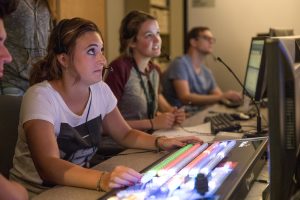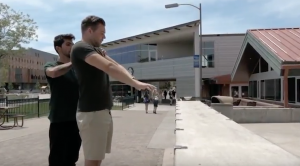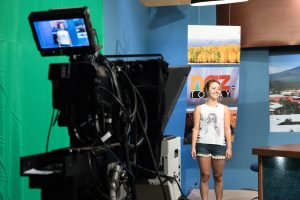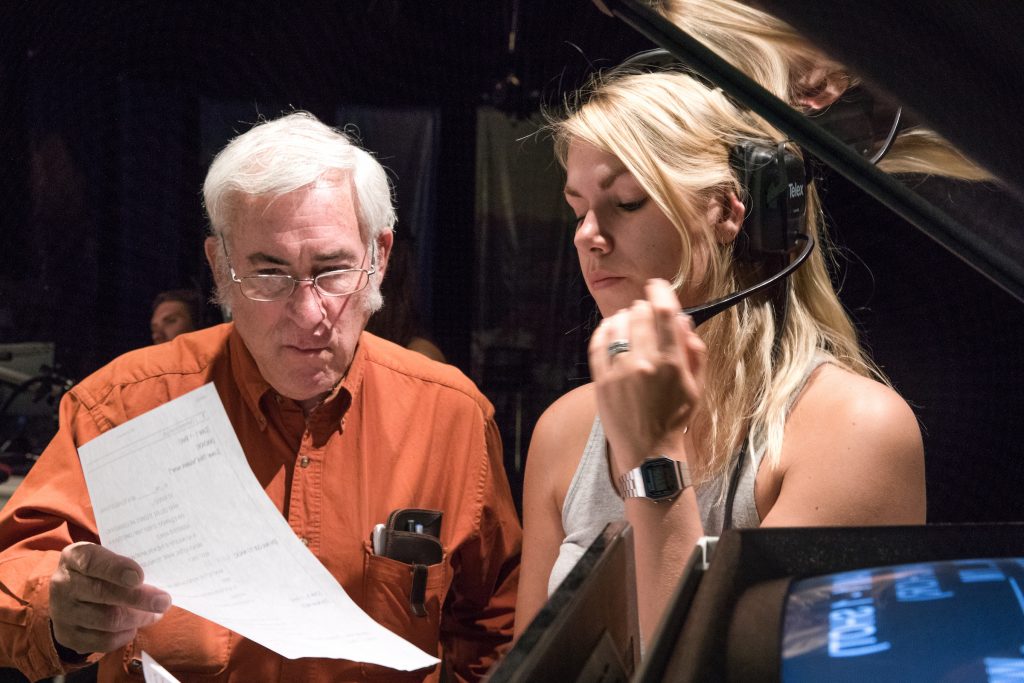Marielle de la Fuente was tired.
She’d spent hours the previous day dancing—line dancing, square dancing, two-stepping—any kind of dance in which a shout of “yeehaw!” was appropriate when the music ended. And that was only Tuesday. On Thursday she was interviewing folk singer and storyteller Tony Norris and Friday she’d learn the ins and outs of a local country radio station.
Oh, and she did all of it on camera in a language that’s not her first.
De la Fuente is one of almost 40 college students from the Netherlands who came to Northern Arizona University for an intensive video workshop. For 14 years a cohort of Dutch media students have come for what they now officially call The Flagstaff Experience—three weeks of brainstorming ideas, setting up interviews, shooting and editing video and doing live shots, all of which culminate in an hourlong video magazine show that is broadcast live.
“I feel at home here after just one week,” said de la Fuente, whose on-air segment was about cowboy entertainment. “Everyone is so welcoming. It makes it easy and exciting as we’re doing all the work.”
Coming to America
Paul Helford, a lecturer in the School of Communication and director of the NHTV Netherlands Video Workshop, gave one reason NHTV Breda University of Applied Sciences in Breda, the Netherlands, embraced the partnership with a university 5,000 miles away—NAU’s three-camera high-definition television studio.
There are other good reasons—proximity to the Grand Canyon, southern California, Las Vegas and other places allow the students to experience different aspects of American culture; already-established relationships between the universities, expertise in the material. But the studio is a big deal, Helford said. Few universities have a professional-quality TV studio that’s available during the summer months. Thanks to an agreement between NAU-TV and the School of Communication, NAU has that.

The program has stayed about the same since its first year, Helford said, with NAU professors teaching classes on the technical skills and helping them hone ideas and set up their interviews. The students live on campus and go to classes; Bob Reynolds teaches them how to use NAU’s equipment, Dale Hoskins and now Brian Rackham teach writing and announcing for TV, and Todd Birch is the studio teacher.
In addition, 10 students worked the workshop, providing writing and editing help, going along for the ride (and to provide on-site help) when the students do their field pieces and providing the college social experience that often doesn’t differ from continent to continent. Students from Breda University do similar workshops in Bournemouth, England, and Hilversum, the Netherlands.
Those are the official reasons. The students’ reasons are a bit more fun.
“Going to America has been a dream of mine ever since I was a child,” Dylan Ijsselstein said. “It was such a good opportunity I felt like I had to take it.”
Neill Baas and Marieke Peters echoed Ijsselstein; for all their lives they’ve dreamed of coming to the United States. Peters chose the NHTV program in large part because of the Flagstaff workshop. She’s also sticking around for a couple of weeks to explore the California coast, Yosemite National Park and Las Vegas.
“I really love the American people,” she said. “They’re all so nice.”
Discovering the ins and outs of Northern Arizona
The students divided into teams of three, with each student picking a primary task—on-air talent, producer and editor/shooter—though all the students did a little bit of everything throughout the workshop. Each team did a segment that fits into one of three chunks of the show: Artizona, From Coward to Cowboy and Arizona from Above.
Faculty members were there to teach, guide, direct and answer questions, but the work of conceiving and producing the hourlong show falls squarely on the students’ shoulders. They spent much of the first week learning the equipment, practicing using a teleprompter and planning their field shoots. A few teams actually went out and shot during the first week, including going to the First Friday Art Walk.
The second week they all split up, heading to artists’ homes and studios, music venues, the Lowell Observatory, the Snowbowl and other known and lesser known northern Arizona landmarks.
Baas’ team not only shot their story in the field, they camped one night at Babbitt Ranch. He didn’t love the camping part, but he called it part of the

American experience.
“It’s a real ranch with real cowboys,” he said. “We’re talking to them about what you need to do or be to be a cowboy, hoping to gain insight into what cowboys do for a living.”
Baas was the editor and cameraman for his team, learning much of that here in Flagstaff. At NHTV the students study in the international media and entertainment management program. Although many of the students have some video shooting and editing experience, the program in Breda does not focus on production. Here at NAU they have three weeks of video production immersion. By day two the students are in the field, doing stories about the NAU campus that serve as templates for their video story packages.
The camera work was much easier for Peters, who owns a production company. She has not, however, filmed the creation of cowboy boots before. Her team did a segment on how cowboys dress, so they talked to artisans who made boots, hats and even saddles.
“At first I was not so interested in the subject, but now I’m really into it,” she said a week and a half into the workshop. “It’s something different, something we don’t have in the Netherlands.”
They also explored other aspects of northern Arizona. The group went on field trips during the weekend, going to Slide Rock, Sedona, the Grand Canyon and Las Vegas, in addition to hanging out with the student workers and experiencing Flagstaff nightlife.
“I think the weekends are the most fun,” Baas said.

Finishing touches
The final week of the workshop was an entirely different experience. The students edited stories, filled in information gaps, put their segments together and practiced. Student workers were on call for shifts in the wee hours of the morning, as Helford knew the Dutch students would be up until 3 or 4 a.m. putting pieces together. On Tuesday, 48 hours before the big day, they started run-throughs and story reviews, then went back to editing and revising as they realized what worked and what didn’t.
Wednesday was much the same, though with less editing and more practicing. On Thursday, each program got a run-through an hour before its scheduled time, and then each group put on its 20-minute live show, broadcast to anyone interested in watching, including an excited group of family and friends in the Netherlands.
That was a long day.
On Friday the group watched the full show together. There were critiques, but not then; Helford said the group viewing is a chance to appreciate how hard the students worked for the past three weeks. The hourlong program included stories an entertainment venues in Flagstaff, the small but enthusiastic parkour community, local restaurants, hiking trails and sunsets. One crew even flew in a small plane to get the true Arizona from above experience.
The 38 students ribbed the students on-screen, laughed at the Arizonaisms that didn’t quite translate into Dutch and cheered and clapped as each segment came to an end.
It was a satisfying close to an exhausting and exhilarating three weeks, which translated into 11 credit hours. De la Fuente said her parents and boyfriend tuned in back home and gave her rave reviews.
“We all didn’t have much experience at all, and we all came out of here and are skilled,” said de la Fuente, who in addition to her cowboy entertainment segment co-anchored the “From Coward to Cowboy” show with Peters. “We all changed from doing this.”
Watch Artizona, From Coward to Cowboy and Arizona from Above.



